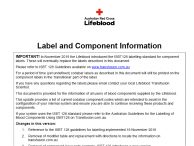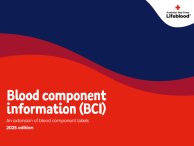Don’t have an account?
Select the donation type you’d like to make
The following list shows label modifier texts and their clinical indications.
- Autol release - see disclaimer
This autologous component has tested positive for one or more viral markers but has been released upon request by the patient’s physician. A disclaimer form will accompany these components.
- CMV negative
The originating donor sample/donation has been tested for CMV antibody and is negative.
- For intrauterine transfusion
A hyper-concentrated red cell component with a haematocrit of 0.70-0.85. After preparation, the expiry is reduced to 48 hours and the component must be irradiated before use.
Once irradiated, the component must be used within 24 hours.
- IgA deficient
The originating donor sample/donation has been tested and is IgA deficient.
- Low anti-A/B
The originating donor sample/donation has low levels of anti-A/B haemolysins.
- Not for neonatal use
The component has been deemed unsuitable for neonatal use due to the presence of red cell antibodies (low titre only).
It should not be transfused to a neonate.
- Not NAT tested
Due to extenuating circumstances (e.g. machine failure or specific clinical demand), this component has been released without nucleic acid technology (NAT) testing being performed. A disclaimer form will accompany these components.
- Phenotype reserve
The originating donor sample/donation or, the donor previously, has had an extended phenotype performed, and forms part of a panel of cells reserved for patients with antibodies or where antigen negative blood is otherwise specifically required.
- Secretor plasma Le(b+)
The component is from an Le(a-b+) donor and contains soluble H and Lewis antigens (and A or B antigens if the donor is group A or B). May be used to neutralise a recipient’s Lewis or A or B antibodies. Suitable for transfusion.
- Suitable for research
The component is deemed unsuitable for clinical use, but may be used for research purposes. (These components will never be issued for transfusion).
Note: CMV (cytomegalovirus)
Updated October 2025



